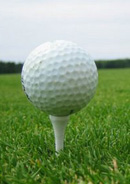 There
is a lore among golfers that warm golf balls go further with the
same hit than those that are colder. As a result, on cold days a
golfer will often keep his/her ball in a pocket until just before
teeing off. This led to the following investigation, one that can
be done with relatively little equipment, and leads to further
investigations.
There
is a lore among golfers that warm golf balls go further with the
same hit than those that are colder. As a result, on cold days a
golfer will often keep his/her ball in a pocket until just before
teeing off. This led to the following investigation, one that can
be done with relatively little equipment, and leads to further
investigations.The first question:
How fast does a warm golf ball
cool off when placed on a tee on a cold day? (How much time do
you have to strike the ball before it cools off?)
Other questions to consider:
1. How fast does the outside of
the golf ball cool off compared to the center of the ball?
2. Does it matter if the ball is composed of a single piece, two pieces, etc.?
3. Does the rate of cooling depend in any way on wind?
4. Does a warm golf ball really go further than a cold golf ball with the same hit?
2. Does it matter if the ball is composed of a single piece, two pieces, etc.?
3. Does the rate of cooling depend in any way on wind?
4. Does a warm golf ball really go further than a cold golf ball with the same hit?
Suggested equipment:
* Golf ball(s)
* Data Collection device
* Surface Temperature Probe
* Fan
* Anvil
* Motion Detector or Video Camera
* Data Collection device
* Surface Temperature Probe
* Fan
* Anvil
* Motion Detector or Video Camera
Suggestions:
1. Drill small hole (5/64”) in
ball to insert Surface Temperature Probe. Depth can vary for
different investigations.
2. If it’s too warm outside, consider running the experiment in a refrigerator or freezer.
3. One thing possibly affected by temperature would be the coefficient of restitution. One way to investigate this is to drop objects from a standard height onto an anvil and observe the height of the bounce.
4. Report your results to your favorite golfer, especially if they are going to play during cold conditions, in a form they can understand and apply them to their game.
2. If it’s too warm outside, consider running the experiment in a refrigerator or freezer.
3. One thing possibly affected by temperature would be the coefficient of restitution. One way to investigate this is to drop objects from a standard height onto an anvil and observe the height of the bounce.
4. Report your results to your favorite golfer, especially if they are going to play during cold conditions, in a form they can understand and apply them to their game.
Online reference: http://sportsnscience.utah.edu/the-chemistry-behind-golf-balls/
C. Bakken
December 2013
Download MS Word version
Download pdf version